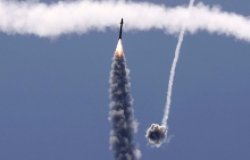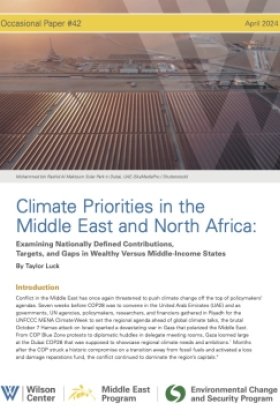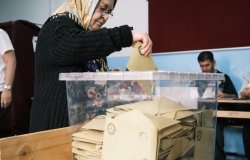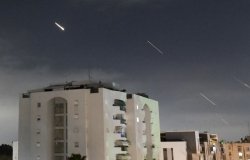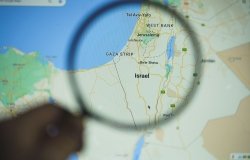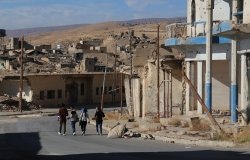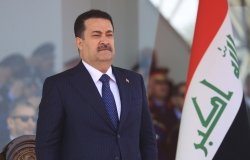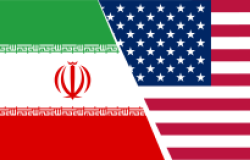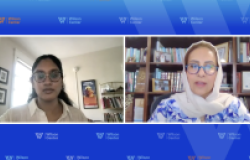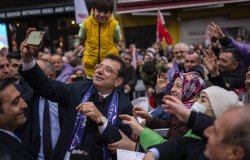Iran on the Eve of the Presidential Elections
Mark J. Gasiorowski, Professor, Department of Political Science, Louisiana State University; Mohsen Sazegara, Visiting Fellow, Washington Institute for Near East Policy, and journalist and politician in Iran; Barbara Slavin, Senior Diplomatic Reporter, USA Today. Discussant: Suzanne Maloney, Policy Planning Staff, U.S. Department of State.This event is cosponsored with the National Defense University's Institute for National Strategic Studies.
Overview
Speakers:
Mark J. Gasiorowski, Professor, Department of Political Science, Louisiana State University
Mohsen Sazegara, Visiting Fellow, Washington Institute for Near East Policy, and journalist and politician in Iran
Barbara Slavin, Senior Diplomatic Reporter, USA Today
Discussant: Suzanne Maloney, Policy Planning Staff, U.S. Department of State
This event was cosponsored with the National Defense University's Institute for National Strategic Studies.
Mohsen Sazegara provided perspective and background on the upcoming elections. He divided post-revolutionary Iran into three "republics": clerical rule under Ayatollah Khomeini, a tentative political balance under President Ali Akbar Hashemi Rafsanjani, and the reform era of Mohammad Khatami's presidency. The third republic—the period of reformism—is over, Sazegara said, and a fourth republic is stepping into its place.
Sazegara dissected the groups backing the particular candidates. Behind Ayatollah Khameini, Sazegara placed Kayhan newspaper, the Revolutionary Guards, and other militant organizations, the Foundations and the Islamic Coalition Councils, and several clerical groups from Qom and Tehran. He suggested that Khameini's front comprised 10-15% of the electorate. He talked about the Islamic Coalition Council, a powerful party with connections to the bazaar and 90 seats in Parliament (of 290), and its associated groups. These groups are moving in Rafsanjani's direction, and away from the conservative candidates backed by Khamenei. The conservative movement is further divided by the number of hardline candidates: Ali Larijani, former head of state broadcasting; Mohammed Baquer Ghalibaf, former chief of Iranian police; Mahmoud Ahmadinejad, Mayor of Tehran; and Mohsen Rezai, former commander of the Revolutionary Guards.
Rafsanjani's supporters, the Executive of Construction, are a small but wealthy group, and have a voice in the widely-read reformist Shargh newspaper. Sazegara suggested that Rafsanjani has two cards he is trying to play: his intention to solve the "U.S. problem" and a coalition with intellectual/modern groups. Rafsanjani has been unable to play either card, Sazegara asserted: the U.S. has given no indication it is willing to talk with Rafsanjani, and intellectuals are largely shunning him and pushing for constitutional reform.
Opposition groups like the University Students Office of Consolidation are pushing for a boycott of the election and some support a referendum on the constitution. As a result, Sazegara predicted a turnout of only 25-30%, with 10-15% of the electorate going to Khameini's candidates and 7-8% to Rafsanjani. He characterized Rafsanjani's challenge as bringing the reformists to his banner, the group that brought Khatami to power in a landslide in 1997, but are now more likely to refrain from voting. Sazegara did not think Rafsanjani would win the election, but suggested that for anyone outside the conservative group to win, they would have to convince the electorate that Khameini cannot control everything—that they can wield power independent of the Supreme Leader.
Mark J. Gazirowski looked at the likely results of the election. He considered three potential outcomes: a reformist victory, a hardline victory, and a Rafsanjani victory.
Gazirowski said that the prospect of a reformist victory is extremely unlikely with the disqualification of Mustafa Moin, the reformist candidate, but if Mehdi Karroubi manages to win, it will only be a continuation of Khatami's marginalized, paralyzed presidency. Without the ability to mobilize a base, Karroubi would be unable to accomplish anything. The reformist movement would probably split, with one faction remaining with the government, while the other faction breaking with it.
If a conservative (for example, Ghalibaf) were to win the election, Gazirowski asserted that the outcome would be almost identical. None of the approved conservatives were likely to contest Khameini's rule, and the Presidency would remain marginal. However, there would be one difference: the reformists would feel safe in breaking with the regime and forming a populist resistance movement.
Gazirowski suggested that Rafsanjani would be the likely winner, although the numbers were hard to predict. A Rafsanjani presidency would have two phases: a 6-24 month "honeymoon," in which Rafsanjani would be able to enact some limited reforms with energetic, centrist rule. It will be a shorter, weaker honeymoon than he received in 1989, without many achievements; once it ends, Rafsanjani's presidency will sink into the same marginalization as reformists' and conservatives' would have, and reformists will probably break with the regime once it does.
There are three things that could extend the honeymoon period, Gazirowski argued. First, Rafsanjani could win a clear majority in the first round, with better than 50% turnout. This would give Rafsanjani a mandate, and corresponding political capital. Second, Rafsanjani could build a coalition with reformers, youth, or other groups to put a large popular coalition behind him. Finally, he could score a quick victory to prove himself effective. Gazirowski thought Rafsanjani would probably try to do this by closing the nuclear issue, which he could do solely on his own authority as President. Conservatives will regroup quickly, however, and eventually sideline or dominate Rafsanjani.
Barbara Slavin talked about her experience meeting and interviewing former President Rafsanjani. The campaign, Slavin said, was very much a family affair and she was vetted by Rafsanjani's son, Mehdi Hashemi, and brother, Mohammed Hashemi. They tried to stress several points to her. They sought to create an image of Rafsanjani as the only man in Iran who could seal a deal with the U.S. The family talked about the idea of a "Shi'ite Alliance" against Al Qaeda-style terrorism between Iraq, Iran, and the United States, and stressed Rafsanjani's moderate credentials, and the fact that he has worked with the United States before (during Iran-Contra). Furthermore, they argued, the U.S. is run by a radical, and Rafsanjani is a moderate; if both countries were run by radicals, there would be serious trouble.
Rafsanjani and his family also stressed that he was the only person likely to be able to stand up to the Supreme Leader—and Mehdi Hashemi went so far as to assert that his father would make Khameini a figurehead "like the Kings of England" (which he later denied). Rafsanjani is casting himself as a moderate pragmatist, to appeal to reformists wanting change but tired of Khatami's ineffective leadership.
Slavin also related the results of an "informal survey" she took of Iranians she encountered while visiting the country in February. She found that 70-80% of the people she asked said they would not vote, while the rest nearly all said they would vote for Rafsanjani if he ran, because he could stand up to the Supreme Leader and was "less spineless" than Khatami.
Drafted by Evan Hensleigh
Hosted By

Middle East Program
The Wilson Center’s Middle East Program serves as a crucial resource for the policymaking community and beyond, providing analyses and research that helps inform US foreign policymaking, stimulates public debate, and expands knowledge about issues in the wider Middle East and North Africa (MENA) region. Read more
Thank you for your interest in this event. Please send any feedback or questions to our Events staff.
